Rose
By Debs Cook
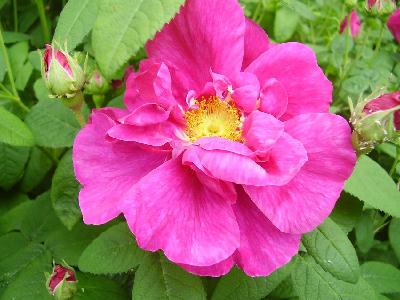
Rosa gallica officinalis
The magic and romance of the rose are known to almost everyone, but the medicinal and culinary uses are not so well known. The romance is illustrated in the arts where the rose has long drawn on for inspiration. In Shakespeare's Romeo and Juliet, Juliet speaks the famous line 'that which we call a rose by any other name would smell as sweet'. Robert Burns described his love as being 'like a red, red rose', and the Greek poet Sappho, in her 600 B.C. poem 'Song of the Rose', referred to the rose as the 'grace of the earth'. The rose features in many flags and emblems around the world and is the national flower of England. English maidens are referred to as 'English roses' and red roses are worn on St George's Day on the 23rd April each year.
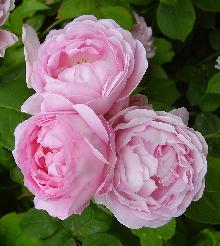
Rosa centifolia
Roses are a recent addition to my garden. This year I added two, rosa gallica's, an officinalis or Apothecary rose, and a Rosa Mundi, also known as versicolour. These were added to an existing Sweetheart rose climber and my favourite 'Brother Cadfael' rose. I've been a fan of roses for a very long time, using the petals to make wine, jam and vinegar. Usually, I use wild roses in the kitchen but more recently I've taken to using cultivated roses with the same delicious results.
History
The first fossil records of the rose date back 35 million years to the Oglicene period. The fossil found closely resembled that of the wild rose 'Rosa rugosa'.
Wreaths of flowers containing roses were found in Hawara in Egypt. They date back to AD 170 and represent the oldest preserved record of a rose species still growing today.t is believed that the roses found in the wreath are the Rosa sancta also known as the Holy Rose. Unfortunately, I couldn't find any R. sancta to photograph but I understand that they resemble the flowers of the sweet briar rose shown later. If anybody knows better, please feel free to correct me.
In 1798, Napoleon's Josephine, created one of the most remarkable rose gardens ever. It is just outside Paris, at her palace come manor house 'Château de Malmaison'. Her garden included every variety known at the time which was then about 250 different kinds.
"Modern" rose hybrids date back to 1867, and by 1920 hybrid teas dominated the market and are still popular today. In Renaissance art, the apothecary rose was the most painted of all roses. Its red colour (which is actually deep pink, as can be seen above) was believed to represent the blood of the Christian martyrs. The petals of the apothecary rose were dried and rolled into beads, then strung into beaded chains for religious use. These beads later became known as the 'rosary'.
Folklore
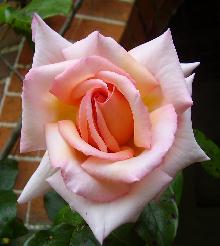
Rosa indica
Sacred to the Goddess of love, Venus to the Romans and Aphrodite to the Greeks, roses in mythology were also symbolic of protection and rebirth. During funeral ceremonies, the Romans scattered rose petals to symbolise resurrection.
It was once the custom to suspend a rose over the dinner table as a sign that all confidences were to be held sacred, and still today the plaster ornament in the centre of a ceiling is known as 'the rose'.
Rose petals sprinkled around the house are said to calm stress and household troubles. Added to baths, they make the skin look younger and make a person appear more beautiful. Planted in the garden, roses are said to attract the fairies and are reputed to grow best when the plant has been stolen, although very few will testify to that claim I'm sure.
Description
Roses have played their part in the Middle East and Europe on a culinary and medicinal level for centuries. They originated in Persia, where an extensive rose-water trade began as long ago as the 8th century. They now come in many shapes and sizes, from miniature roses at only 10cm high to the climbers that can reach up to 20ft in height with a whole host of varieties in between.
There are more than 10,000 roses currently known in cultivation ranging over
- Hybrid Teas - Peace and Whisky Mac,
- Floribundas - Golden Wedding and Remembrance
- Climbers - Cecile Brunner (aka the Sweetheart Rose) and Golden Showers
- Shrub - Gertrude Jekyll and Charles De Mills
- Wild Roses - Rubra (Rosa rugosa) and Dog Rose (Rosa canina).
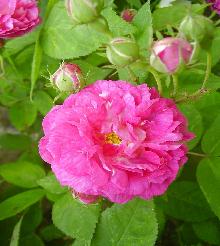
Rosa damascena
The colour range of the rose is as varied as its types. They come in all shades and hues except blue, although, according to some reports, they've bred a mauve coloured rose that is only a few steps away from becoming blue. It's estimated that 'true' blue roses will be available commercially in approximately 7 years which will then give us a new colour to add to our garden designs.
The perfume of the rose is just as diverse as the colour. It ranges from no aroma to sweet rich heady fragrances that can be overpowering. Older rose varieties usually have more fragrance than newer hybridised roses. The three most common fragrances come from the Cabbage Rose (Rosa centifolia), also known as the hundred petal rose, the Tea Rose (Rosa indica) and the Damask Rose (Rosa damascena).
General Use
Primarily today roses are used in the perfume industry. The oil from the Bulgarian rose Kazanlik (Rosa damascena trigintipetala) is considered the best in the world and is used by the likes of Chanel and Christian Dior in their perfumes. It takes 4 tons of roses (or approximately two million flowers) to make 2lb of rose attar (another Persian word for oil, like otto and ottar), which explains why pure rose oil is so expensive. The story of how the early Persians discovered how to extract rose oil is interesting and apparently it happened quite by accident, Mrs. Grieve in her 'A Modern Herbal' tells the tale wonderfully.
"It was between 1582 and 1612 that the oil or otto of roses was discovered, as recorded in two separate histories of the Grand Moguls. At the wedding feast of the princess Nour-Djihan with the Emperor Djihanguyr, son of Akbar, a canal circling the whole gardens was dug and filled with rose-water. The heat of the sun separating the water from the essential oil of the rose was observed by the bridal pair when rowing on the fragrant water. It was skimmed off and found to be an exquisite perfume. The discovery was immediately turned to account and the manufacture of Otto of Roses was commenced in Persia about 1612 and long before the end of the 17th Century the distilleries of Shiraz were working on a large scale."
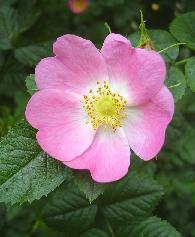
Rosa eglanteria
Many perfumes and cosmetics are made from rose oil. The oil is excellent for use on the skin because of its antiseptic, cooling, moisturising, soothing and nourishing properties.
The petals and hips are often found in pot-pourri both for their colour and fragrance. Dried rosehips are particularly popular in the USA for pot purris because of their ability to hold scent, making them ideal for using as a fixative. Those most often used are the hips of the Dog rose (Rosa canina).
The petals are also dried and sold as natural and biodegradable wedding confetti. The dried petals also make excellent additions to herb pillows and homemade scented paper.
Medicinal Use
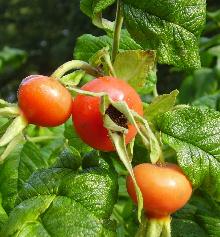
(Rosa rugosa)
The hips resemble small tomatoes and are loaded with vitamin C
Roses have for centuries been valued for their culinary, medicinal, cosmetic and aromatherapy properties. However, only the apothecary rose (R. gallica) and the Dog rose (R. canina) are used for making medicinal remedies. It is the hips of the dog rose that are used because they contain high levels of vitamin C and also flavonoids, tannins and vitamins A, B1, B2, B3 and K. In the middle ages, the Dog rose was heralded as a marvellous cure for chest complaints. The apothecary rose is used today more for its aromatherapy and cosmetic properties than its medicinal properties but it does have sedative and antidepressant properties as well as being astringent and useful for lowering cholesterol. In Chinese medicine, Rosa rugosa also known in China as Mei gui hua is occasionally used as a tonic to boost the liver and as an antidote to some forms of poisoning.
It's a shame that roses are not used more often in medicinal remedies. I have fond memories of being given rose hip syrup to drink as a child when I was poorly. The freshly made syrup seemed to be a cure for most of my childhood ills but maybe it was just the taste acting as a placebo? Most of the old scented roses can be used to make medicinal remedies. The petals can be used to make rose vinegar (see recipe below). To use this to alleviate a headache, especially those induced by heat, soak a cloth in the rose vinegar solution, wring out and apply to the forehead then lay back and relax.
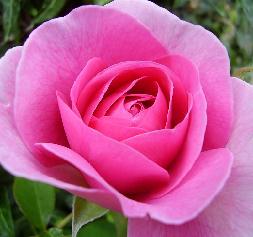
Culpepper said of the oil of rose "It is used to cool hot inflammation or swellings and to bind and stay fluxes of the humours, to sores and is also put into ointments and plasters that are cooling and binding." Gerard provided his own list of health benefits for the rose: "The conserve of roses taken in the morning fasting, and last at night, strengtheneth the heart, and taketh away the shaking and trembling thereof, strengtheneth the liver, kidneys, and other weake entrails, comforteth a weake stomacke that is moist and raw."
Culinary Use
Rose petal and rose hips are used a lot to make jams, jellies, cordials, vinegars and sweets. Rose flavoured Turkish delight has been produced in Turkey since the 15th century and is known there as lokum.
Rosehip syrup is a natural source of vitamin C, containing 20 times more vitamin C than oranges by weight.
Rose petal butter is another delicacy. To make it, take a packet of unsalted butter and wrap it in highly scented rose petals and seal in a container in the fridge overnight. The next day, the butter has a delicate flavour that can be spread on bread and served with a few fresh rose petals to make the classic rose petal sandwich. Rose petal jam makes a delicious filling for cakes and can also be served to accompany meats and used as a topping for scones and toast.
Recipe - Rose Vinegar
I found this recipe in an old book of recipes primarily for wine and beer that belonged to my husband's Grandmother. I've used it to great effect to treat mild headaches using the method given above and as a gargle for sore throats. It's also good to use as a facial toner.
Quantities
- 3 Handfuls Fresh Highly Scented Rose Petals (red or deep pink give the best colour).
- 7 Tbsp's Distilled White Vinegar.
- 1 Tbsp Rose Water
- 1 Pint Distilled Water (you can get this from most chemists).
Method
- Place the rose petals in a glass container and add the wine vinegar
- Leave the container in a cool, dark place for 1 week, shaking the liquid every day
- Strain through a muslin cloth and discard the petals
- To use, dilute the 1 Tbsp of rose vinegar with 1 pint of water.
End note
That's all for this month, I hope that this article inspires you to add a few roses to their gardens if you don't yet have any. Sadly, the photos I've taken don't allow you to smell the delightful scents - that indeed would be magic!
My grateful thanks go to Jan Greenland for her input on the Kazanlik rose and for giving me the opportunity to smell this delightful rose in her garden recently.
